Article
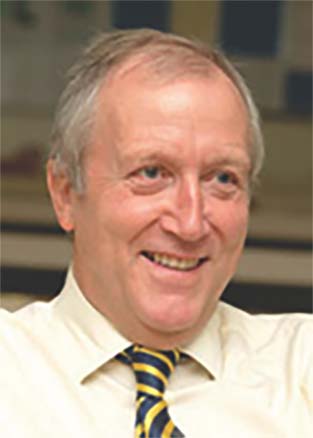
Practice-based research
The value of practice-based research has been previously discussed,1 with the arena of general dental practice having been considered the ideal environment in which to carry out evaluations of the handling of dental materials and their clinical effectiveness. In this regard, a wide variety of research projects may be considered to be appropriate to general dental practice, including assessment of materials, devices and techniques, clinical trials of materials, assessment of treatment trends and patient satisfaction with treatment.1 A UK-based group of practice-based researchers is the PREP (Product Research and Evaluation by Practitioners) Panel. This group was established in 1993 with six general dental practitioners (GDPs), and has grown to contain 31 dental practitioners located across the UK, with one in mainland Europe.2 The group has completed over 70 projects – ‘handling’ evaluations of materials and techniques, and, more recently, clinical evaluations (n = 8) of restorations placed under general dental practice conditions, with the restorations being followed for up to five years.2
Resin composite systems
As patients increasingly move away from amalgam restorations in their posterior teeth,3 with the added impetus of the Minamata Agreement by which the use of amalgam has been banned, from 1st July 2018, in children 15 years and younger and in pregnant and nursing women, dental practitioners have had to use an alternative material, the most appropriate of which is resin composite. In this regard, practice-based clinical evaluations of this material have indicated positive results.4, 5, 6, 7 However, in order to obtain such results, along with the resin composite material, a variety of materials and devices must be employed, for example, a dentine-bonding agent, a suitable matrix system and a polishing system. For the first time, to the authors' knowledge, all of these have been marketed as a single system, the Dentsply Sirona Class II Solution system. It is therefore the aim of this study to evaluate the opinions of a group of practice-based researchers, the PREP Panel, of the components of this system, and the system as a whole.
The Dentsply Sirona products under evaluation therefore are: the dentine bonding system Prime & Bond Active™, the Palodent V3 Sectional Matrix System, SDR® Flow+ composite, Ceram.x Universal composite and the Enhance® Finishing and Polishing System (all manufactured by Dentsply Sirona, Building 3, The Heights, Brooklands, Weybridge, Surrey, KT13 0NY at www.dentsplysirona.com/en-gb).
Methods
Selection of participants
All 31 members of the practice-based research group, the PREP Panel, were sent an email communication asking if they would be prepared to be involved in the ‘handling’ evaluation of a recently-introduced Class II resin composite system. Of those who agreed to participate, 12 were selected at random.
A questionnaire was designed jointly by the PREP Panel co-ordinators and the sponsors of the project in order to seek information on the handling of the various materials and devices which formed the Dentsply Sirona Class II Solution system.
Explanatory letters, questionnaires and a package containing a bottle of Prime & Bond Active™, a Palodent V3 Sectional Matrix System introductory kit, an SDR® Flow+ kit with 4 shades (Universal, A1, A2 and A3), a ceram.X Universal introductory kit and compule gun, and an Enhance® Finishing and Polishing System complete kit were distributed to evaluators in March 2018. The practitioners were asked to use the materials as indicated and return the questionnaires after 10 weeks. At the request of Dentsply Sirona, the evaluation period was shortened to 7 weeks.
Regarding the evaluators, two were female and their average time since graduation was 28 years, with a range of 13 to 45 years.
The evaluation
Dentsply Sirona Prime & Bond Active™
All the evaluators currently used a dentine/enamel bonding system. Reasons for the choice of these materials were primarily ease of use and good results. Other reasons were good research behind product, good ‘wettability’, with comments being made, such as ‘Reliable and effective’ (2 similar), ‘Single dose dispensing’, ‘Practice owner purchase’, ‘Historic use and good results’ (2 similar), ‘Single use dispensing pack’.
When the evaluators were asked to rate the ease of use of the current bonding system, the result was as follows:
Ten (83%) evaluators stated that they preferred a bottle presentation, with 92% (n = 11) of the evaluators also stating that they would not be prepared to pay extra for the convenience of single-unit doses.
The evaluators rated the presentation of Prime & Bond Active™ (Figure 1) as follows:
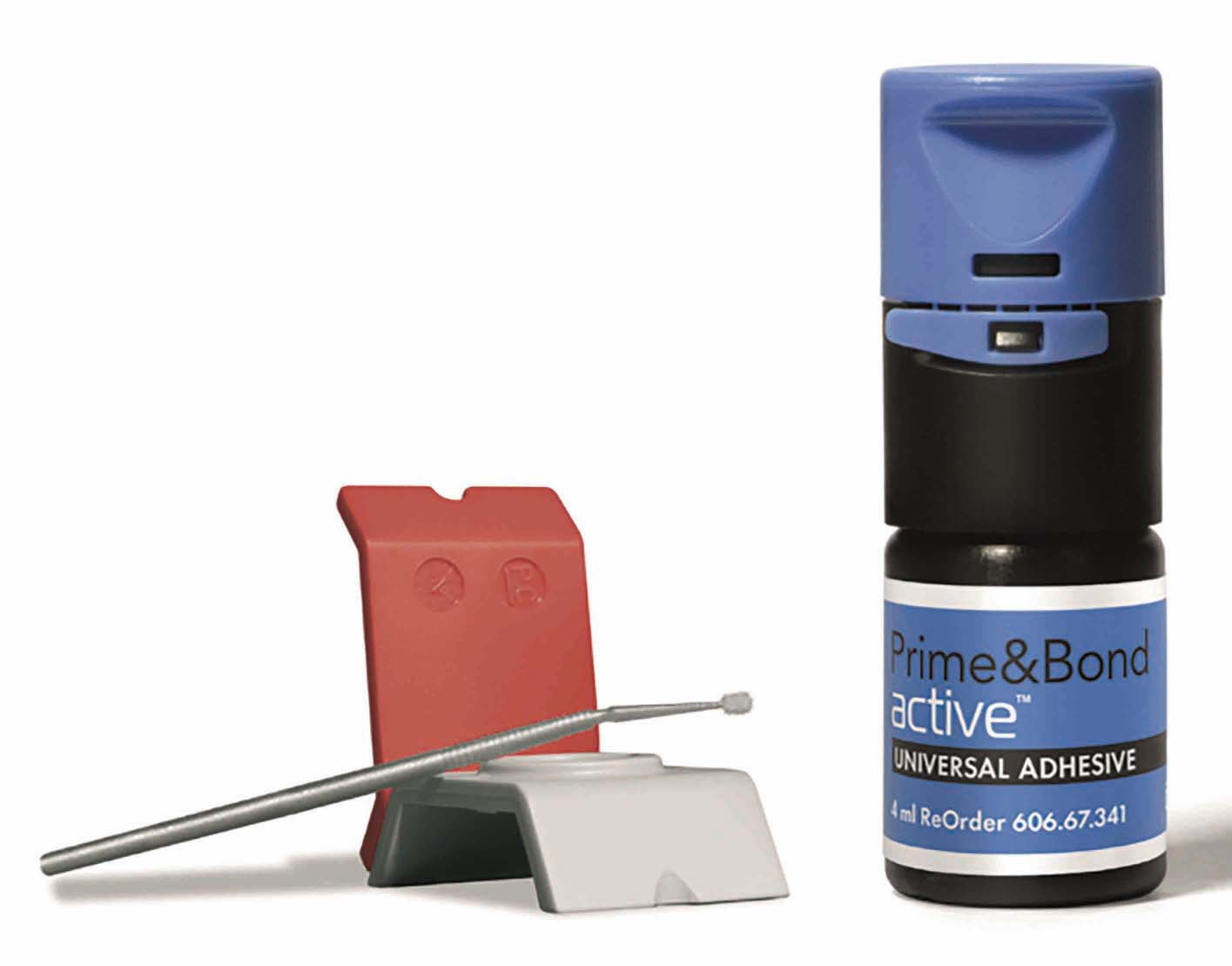
Comment:
‘Use a non-plastic handle for micro-brush’
The bottle dispenser was stated to be easy to use by all (100%) of the evaluators. The cleanliness and ease of cleaning the bottle was rated as follows:
A total of 414 restorations were placed using Prime & Bond Active™, comprising 102 Class I, 125 Class II, 62 Class III, 52 Class IV and 73 Class V.
The mode of etching preferred for Prime & Bond Active™ was stated to be as follows:
| Total Etch | 5 |
| Self Etch | 1 |
| Selective Enamel Etch | 8 |
Eleven (92%) of the evaluators stated that the dispenser worked satisfactorily. However, two comments were made, namely, ‘Lid flimsy and didn't always close fully’.
All of the evaluators stated that the resin liquid easily wet the tooth surface and that the bond was easily visible on the tooth surface. Fifty per cent (n = 6) of the evaluators felt the absence of the need to wash off a separate etching liquid with Prime & Bond Active™ was an advantage and 83% (n = 10) of the evaluators stated that the one-component aspect of Prime & Bond Active™ was an advantage over other systems with more than one bottle.
Four evaluators (33%) stated that the application of Prime & Bond Active™ was faster than the application of other bonding adhesives they had used, with one evaluator stating that it was slower. Seven (58%) stated it was the same as other bonding adhesives and 75% (n = 9) of the evaluators stated that they would purchase Prime & Bond Active™ if available at average price. When they were asked if there were any changes which they considered essential to the acceptability of the material, the following comments were made by three (25%) of the evaluators:
When the evaluators were asked to rate the ease of use of the Prime & Bond Active™, the result was as follows:
Final comments:
Dentsply Sirona Palodent V3 Sectional Matrix System (Figure 2)
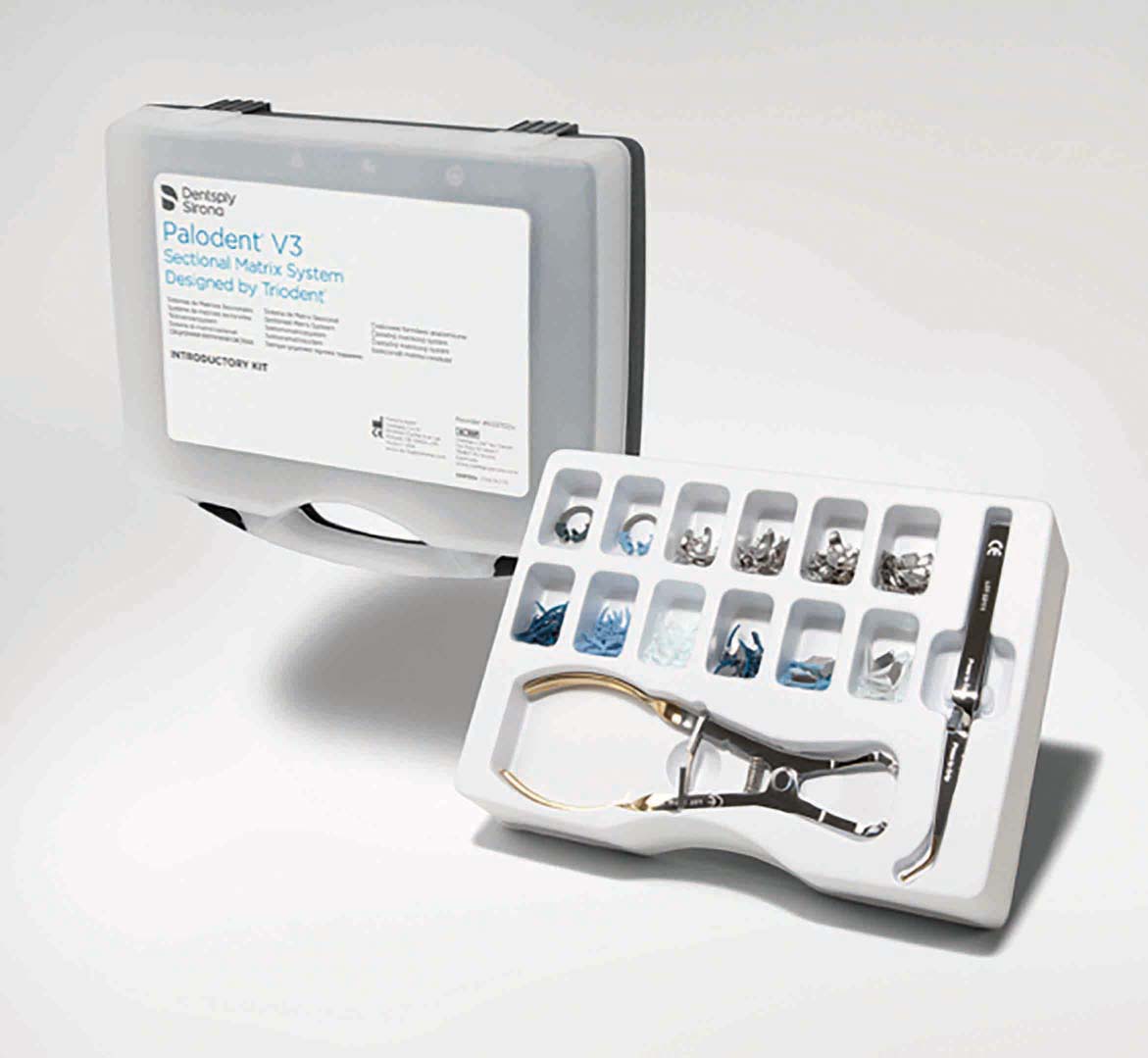
Seven (58%) of the evaluators currently used a sectional matrix system, with five using the V3 prior to the evaluation. The ease of use of the currently used sectional matrix system was rated as follows:
The size of interproximal box for which typically the evaluators used a sectional matrix was as follows:
The evaluators rated the presentation of the V3 matrix system as follows:
All the evaluators stated that the components in the box were neatly laid out and readily identified, and also that the instructions were adequate.
One hundred and sixty-seven restorations were placed using the V3 matrix system, comprising 97 Class II, 47 MOD and 23 cusp replacement. Ten (83%) of the evaluators stated that the matrix was easily held and transferred into place and 75% (n = 9) of the evaluators stated that the locating hole in the matrix was an advantage over systems without such a feature. The curved shape of the matrix was stated to be advantageous by 92% (n = 11) of the evaluators.
The nickel titanium retaining ring of the V3 system was stated by 83% (n = 10) of the evaluators to hold the matrix in place satisfactorily, and the same number also stated that it was easy to place using the ring forceps; 83% (n = 10) of the evaluators found the ring to be advantageous in adapting the matrix to the edges of the box, so reducing the amount of excess composite filling material needing removed.
Comments made included:
Ninety-two percent (n = 11) of the evaluators stated that no patients returned complaining of food packing. If the V3 matrix system was available at an average price, 83% (n = 10) of evaluators would purchase it.
Five evaluators (42%) considered that there were changes essential to the acceptability of the system, making comments such as:
Fifty per cent (n = 6) of evaluators felt that the V3 matrix system was easier to use than a circumferential system.
Comments made included:
It was also suggested that a ‘tips/tricks’ guide would be useful to help with the learning curve.
The ease of use of the V3 matrix system was rated as follows:
The five evaluators new to sectional matrices rated the ‘steepness’ of the learning curve as follows:
Eighty-three percent (n = 10) of evaluators would recommend the Palodent V3 matrix system to colleagues.
Dentsply Sirona SDR® Flow+
The presentation of the kit was rated by the evaluators as follows:
Comment:
The evaluators rated the directions for use of SDR® Flow+ as follows:
Ninety-two percent (n = 11) of the evaluators had previously used Bulk Fill materials.
Stated uses included:
Half of the evaluators also used SDR® Flow+ for other indications, such as restoration of fractured cusps, base of deep boxes (3 similar), repairs and Class V restorations, and for sealant restorations.
The total number of posterior restorations placed using SDR® Flow+ was 127, comprising:
| Class I | 28 |
| Class II | 72 |
| Other Cavity Classes/Indications | 27 |
The comments of the evaluators on whether they would use SDR® Flow+ for certain procedures are presented in Table 1.
| Procedure | Number who would consider using SDR® Flow+ for this procedure |
|---|---|
| Amalgam | 4 |
| Glass ionomer open-sandwich technique | 2 |
| Glass ionomer closed-sandwich technique | 2 |
| Bulk fill posterior composite | 5 |
| Layering of universal composite | 7 |
| Flowable as a liner | 11 |
| Flowable as a bulk fill base | 7 |
Seventy-five percent (n = 9) of the evaluators stated the viscosity of the material was satisfactory. When the evaluators were asked to tick in a table whether they found SDR® Flow+ to be better, the same or worse (than other similar materials that they have used), the results were as in Table 2.
| Better | The Same | Worse | |
|---|---|---|---|
| Simplicity of procedure (convenience/fewer steps) | 7 | 3 | 1 |
| Internal cavity adaptation | 6 | 4 | 1 |
| Ease of placement | 7 | 3 | 1 |
| Creation of positive contact when used with V3 | 1 | 7 | 1 |
| Time saving | 7 | 4 | 0 |
Ninety-two percent (n = 11) of evaluators stated that they were satisfied with SDR® Flow+, and 75% (n = 9) would purchase the material.
The following attributes of SDR® Flow+ were rated by the evaluators as follows:
After having used SDR® Flow+, the evaluators' comments on the concept of bulk filling under resin composite restorations for posterior teeth were as follows:
Final comments on SDR® Flow+ included:
Dentsply Sirona ceram.X Universal resin composite material (Figure 3)
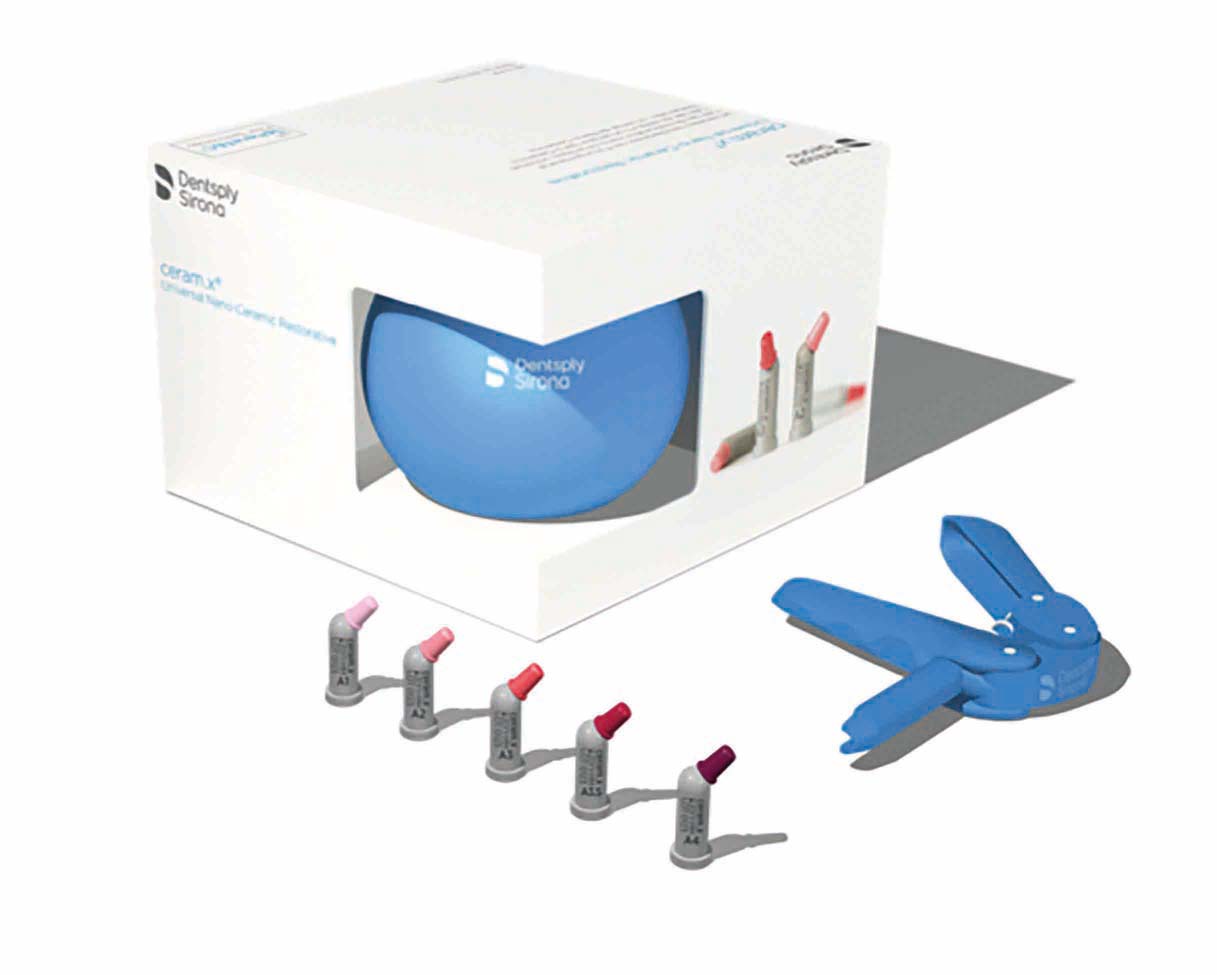
The evaluators rated the ease of use of their current resin composite material as follows:
The overall presentation of the kit was rated as:
The evaluators rated the illustrated technique guide/instructions for ceram.X as follows:
One hundred and forty-five restorations were placed using ceram.X Universal, with 66% being Class II/MOD. All (100%) the evaluators stated that they were satisfied with ceram.X, with only one evaluator encountering post-operative sensitivity (which settled after one week).
The ease of use of ceram.X was rated by the evaluators as follows:
The viscosity of ceram.X was stated to be satisfactory by all 100% of the evaluators.
The evaluators rated the working time of ceram.X as follows:
The ease of finishing and polishing of ceram.X was rated as follows:
Seventy-five percent (n = 9) of the evaluators stated that the number of shades were adequate. Comments made included:
All the evaluators stated that, after sculpting, the restorations of ceram.X Universal maintained their shape prior to curing. Eleven (92%) of the evaluators stated that they would purchase ceram.X Universal if it were available at an average price, and all would recommend it to colleagues. Final comments regarding the performance/handling and overall acceptability of ceram.X included:
Dentsply Sirona Enhance® Finishing System (Figure 4)
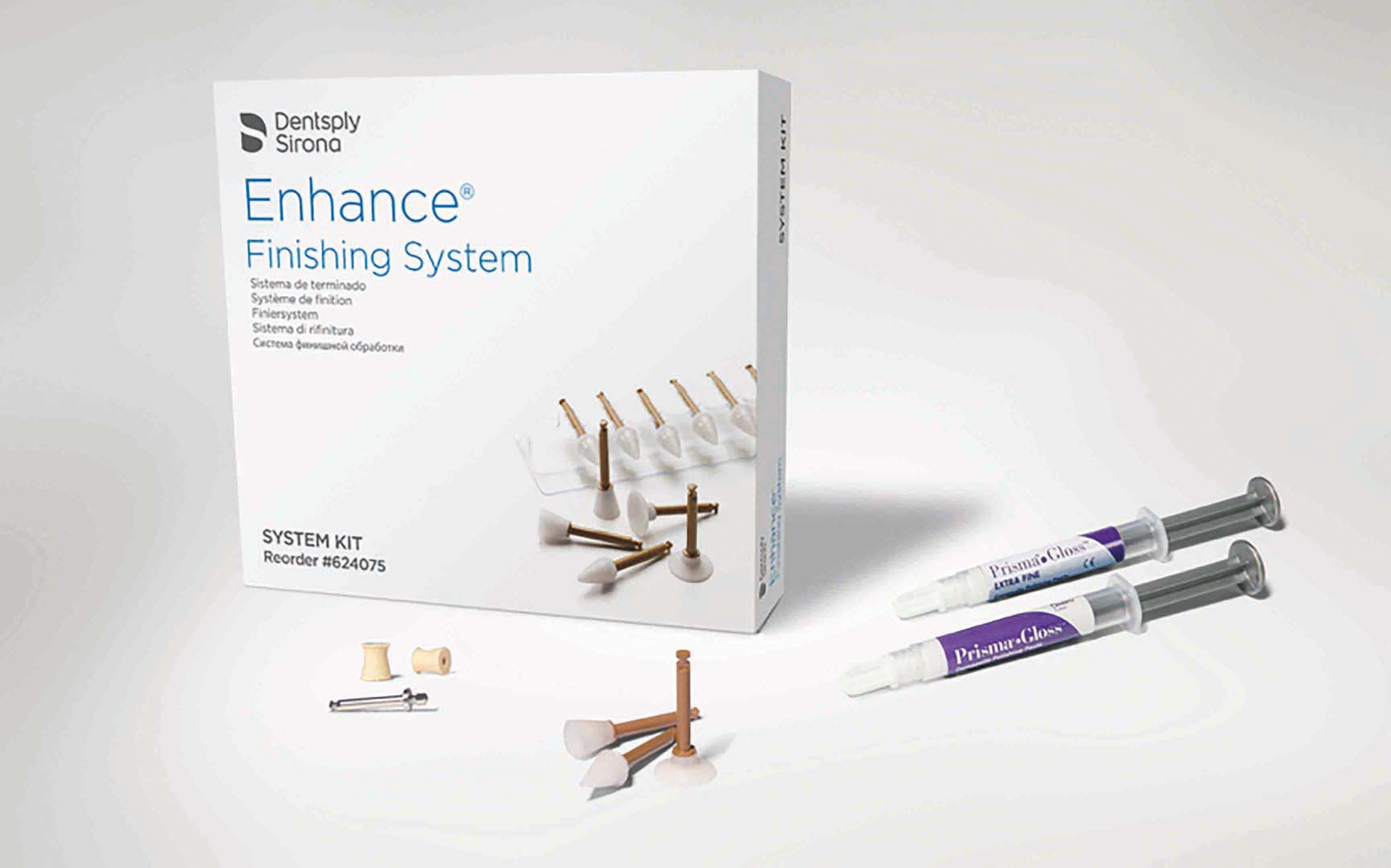
The presentation of the Enhance® Finishing System kit was rated by the evaluators as follows:
The evaluators rated the instructions for the kit as follows:
A total of 200 composite restorations were polished using Enhance®, comprising 37% of anterior restorations and 63% of restorations in posterior teeth.
The evaluators and their dental nurses rated the overall performance of the Enhance® system as follows:
Comments:
All the evaluators stated the Enhance® Finishing discs, cups and points were suitable for both anterior and posterior restorations.
When the evaluators were asked which finisher they used most frequently, the response was as follows: Most frequently: Discs: 4; Cups: 1; Points: 6 All three equally: 3 Least frequently: Discs: 2; Cups: 7; Points: 1
Sixty seven percent (n = 8) of the evaluators stated that the polishing cups were satisfactory.
Comments relating to the cups:
Comments made on the Prisma® Gloss™ and Prisma® Gloss™ Extra Fine pastes were as follows:
When the evaluators were asked if the finish on the restorations was satisfactory, the response was as follows:
The response when the evaluators were asked to describe how Enhance® compared to the polishing system previously used, the result was as follows:
| Better | 5 evaluators |
| Same | 5 evaluators |
| Worse | 1 evaluator |
| No response | 1 evaluator |
The time needed to achieve polish was stated to be:
| Better | 3 evaluators |
| Same | 7 evaluators |
| Worse | 1 evaluator |
| No response | 1 evaluator |
The evaluators stated that, on average, the same polishing instrument was used twice before it needed to be replaced.
The product features of the new polishing system that most satisfied the evaluators were stated to be:
The evaluators rated the overall ease of use of the Enhance® system as follows:
Eighty-three percent (n = 10) of the evaluators would recommend the Dentsply Sirona Enhance® Finishing System to colleagues.
Final comments:
Discussion
Prime & Bond Active™
The Dentsply Sirona Prime & Bond Active™ adhesive system is one of the new group of ‘Universal’ dentine bonding systems, so called because they have been designed to work satisfactorily in whichever etching mode (self-etch [ie no etchant], total etch [ie both enamel and dentine etched with phosphoric acid], or selective enamel etch [in which only the enamel is etched]).8 In common with other recently introduced ‘Universal’ dentine bonding systems, the bonding agent contains the resin 10-MDP (Table 3), alongside the resin PENTA, which has been a component of Dentsply's bonding systems for many years. The inclusion of 10-MDP, which was developed in the 1980s, may be considered to be advantageous in bonding to tooth substance because it forms a chemical bond ionically to calcium, ie to hydroxyapatite in dentine, whereas bonding agents (without 10-MDP) had previously only achieved their bonding by micromechanical means involving the formation of the ‘hybrid layer’.9
| 10-MDP |
| PENTA |
| Initiator |
| Isopropanol |
| Water |
Prime & Bond Active™ bonding agent has been subjected to an extensive evaluation in clinical practice in the present study, in which 414 restorations were placed by members of the PREP panel. The presentation of the material scored very highly (4.9) on visual analogue scales (where 5 = excellent and 1 = poor). Prime & Bond Active™ achieved the same high rating by the evaluators for ease of use as the previously used adhesive system (4.8 on a visual analogue scale (where 5 = easy to use and 1 = difficult to use).
Palodent V3 Sectional Matrix System
The achievement of a tight, correctly-placed interproximal contact (Figure 5) has exercised clinicians for many years, since matrix systems, such as the Siqveland, which work satisfactorily for amalgam restorations, have not been shown to be suitable for resin composite Class II and MOD restorations. The introduction of sectional matrix systems has facilitated the achievement of satisfactory interproximal contacts, as evidenced by a study from the Netherlands.10
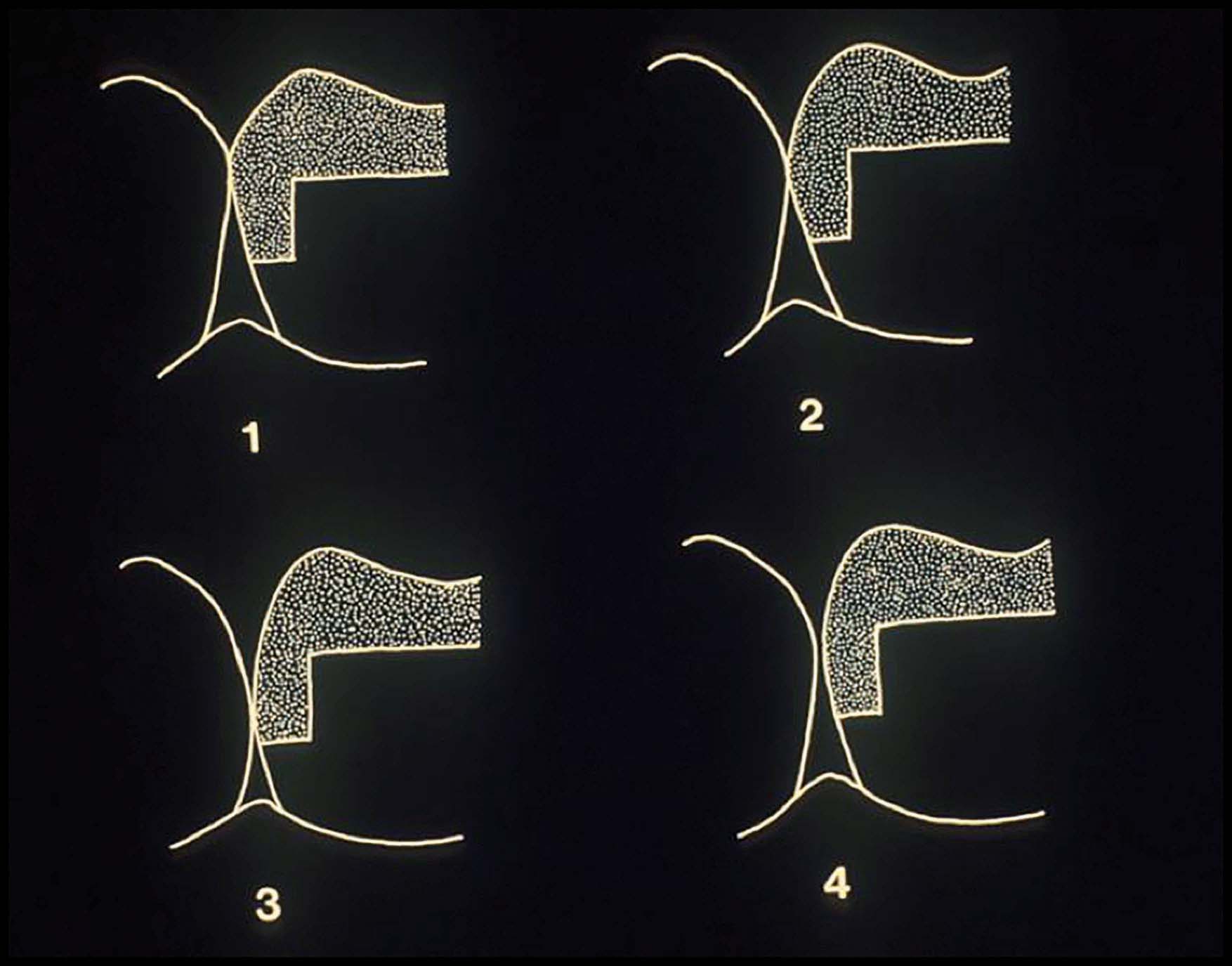
In this regard, The Palodent V3 Sectional Matrix System has been subjected to an extensive evaluation in clinical practice by members of the PREP panel. Eleven evaluators (92%) reported no patient complaints of interproximal food packing following use of the system, indicating that the matrices had achieved their objective, namely, a firm anatomically correct contact point on most occasions. The system achieved a similarly high rating by the evaluators for ease of use as their previously used sectional matrix system, (4.2 v 4.3 on a visual analogue scale where 5 = easy to use and 1 = difficult to use), but this may be considered unsurprising, given that five evaluators already used the system. It is of interest to note that some evaluators did not appear to be limited by the interproximal box width when using the system, with 7 using it for a ‘wide box’ and 5 for cusp replacements, which previously might have been considered to be the territory for a circumferential system.
Figures 6 and 7 demonstrate the satisfactory interproximal contacts which may be achieved.
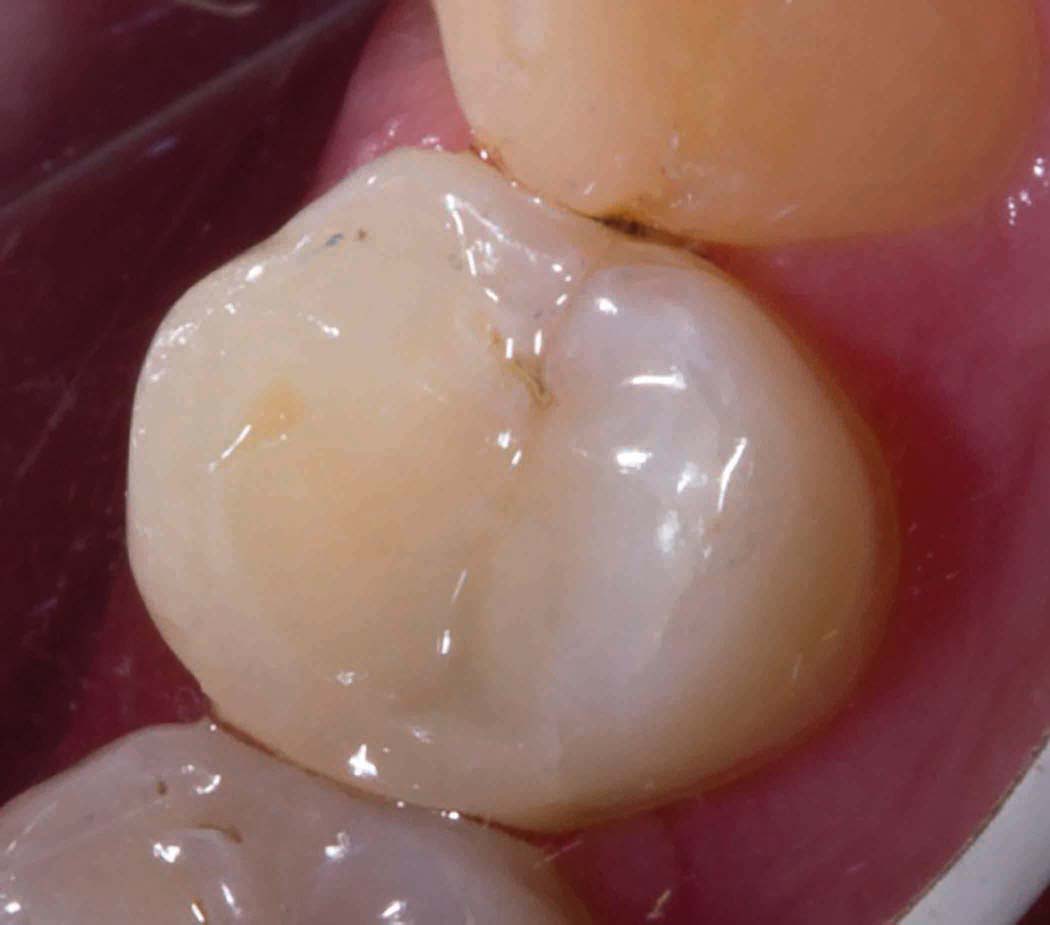
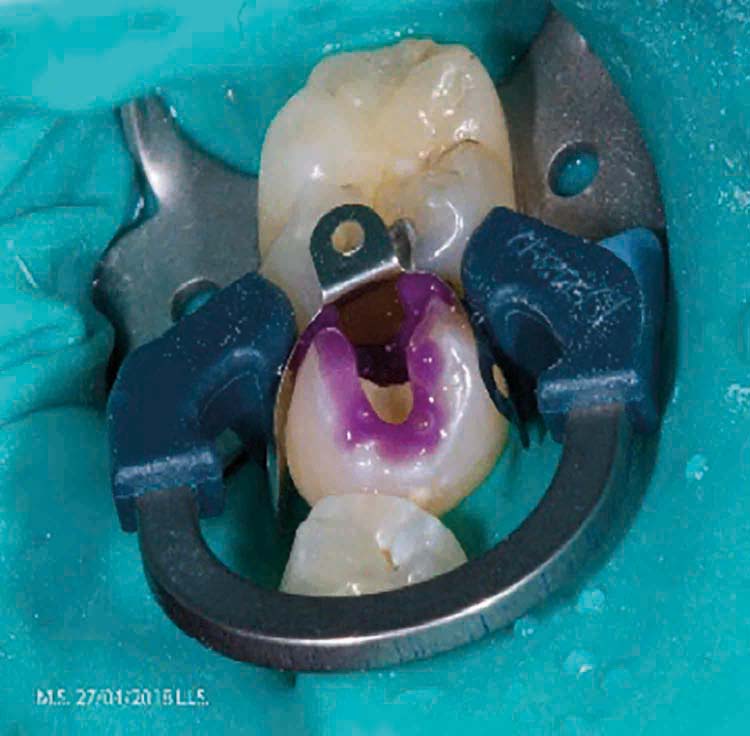
Dentsply Sirona SDR® Flow+
The original Dentsply SDR® Flow+ was designed as a low shrinkage stress material for bulk filling restorations in posterior composite at depths of up to 4 mm, followed by placement of a resin composite outer layer. Dentsply Sirona SDR® Flow+ is, similarly, a low stress material. It has been subjected to an extensive evaluation in clinical practice by members of the PREP panel, in which 127 restorations were placed. It scored highly in all of the attributes which were rated, but principally on its ‘simplicity of procedure’ and ‘internal cavity adaptation’. In addition, when the comments of the evaluators are examined, it is apparent that at least half considered that the use of SDR® Flow+ saved time during the placement of a posterior composite restoration.
Ceram.X Universal
Dentsply Sirona ceram.X Universal has been subjected to an extensive evaluation in clinical practice by members of the PREP panel, in which 145 restorations were placed. The presentation of the system score (3.6 on a visual analogue scale where 5 = excellent and 1 = poor) was the only aspect of the evaluation which scored suboptimally, given that ceram-X Universal otherwise featured exceptionally high scores for the material. Comment was made by over half the evaluators of the impractical nature of the packaging: the authors are, however, advised that the evaluators were provided with a promotional pack, and not the packaging that is in current use. This aside, the material scored very highly, including bettering the score for ease of use of the previously used resin composite material (4.8 v 4.3 on a visual analogue scale where 5 = easy to use and 1 = difficult to use) and with all the evaluators stating that they would recommend the material to colleagues, and also that 92% would purchase the material.
Enhance® Finishing System
Dentsply Sirona Enhance® Finishing System has been the subject of an extensive evaluation in clinical practice by members of the PREP panel, in which 200 restorations were polished. The Enhance® Finishing System scored very highly for ease of use (4.6 on a visual analogue scale where 5 = easy to use and 1 = difficult to use) and 83% of the evaluators stated that they would recommend the material to colleagues. In this regard, it is interesting to note the findings of a paper by Daud and colleagues11 who, in a laboratory study, examined the surface roughness of resin composite specimens polished using different systems. Their results indicated that the Enhance® Finishing System produced significantly smoother surfaces than the Sof-Lex™ (3M) system. Also perhaps of interest is the fact that finishing with a tungsten carbide finishing bur produced significantly less surface irregularity than finishing with a 20 micron diamond finishing bur and that the nano-filled composite under test produced more baseline specimens than the hybrid composite.
Conclusions
The good reception of Prime & Bond Active™ was underlined by the fact that the majority of the evaluators would purchase the material if available at average cost and because of the very high score for ‘ease of use’.
The good scores achieved by the Palodent V3 Sectional Matrix System are underlined by the doubling of numbers of evaluators from the 5 original users of the system, to 10 who would recommend the system to colleagues.
The positive reception of Dentsply Sirona SDR® Flow+ is underlined by the 92% of evaluators who were satisfied with the material and who would also recommend it to colleagues.
The positive reception of Dentsply Sirona ceram.X Universal is underlined by the 92% of evaluators who would purchase the material and the 92% who would also recommend it to colleagues.
The Dentsply Sirona Enhance® Finishing System has been well received and overall achieved high scores, with 83% of the evaluators stating that they would recommend it to colleagues.
Final, unsolicited comments from the evaluators included:
Six evaluators (50%) considered that the kit made the average cost of placing a direct composite clearer, to the benefit of their business, making comments such as:
Concluding comments
This is the first instance in which, to the authors' knowledge, all the components required for placement of a Class II resin composite restoration have been brought together in one complete kit. The individual components performed well in this ‘handling’ evaluation, but the concept of having all components in one kit appeared to appeal to many of the evaluators, especially with regard to calculating the material cost of a given restoration if the manufacturers could suggest the number of restorations that the kit might produce.
Finally, Figure 8 presents a preventive resin restoration placed using the components of the system (except for the matrix system) and Figure 9 presents a restoration placed using all the components of the Dentsply Sirona Class II Solution system. All restorations illustrated in this paper were placed by Dr Peter Sands, General Dental Practitioner, Abingdon, UK.
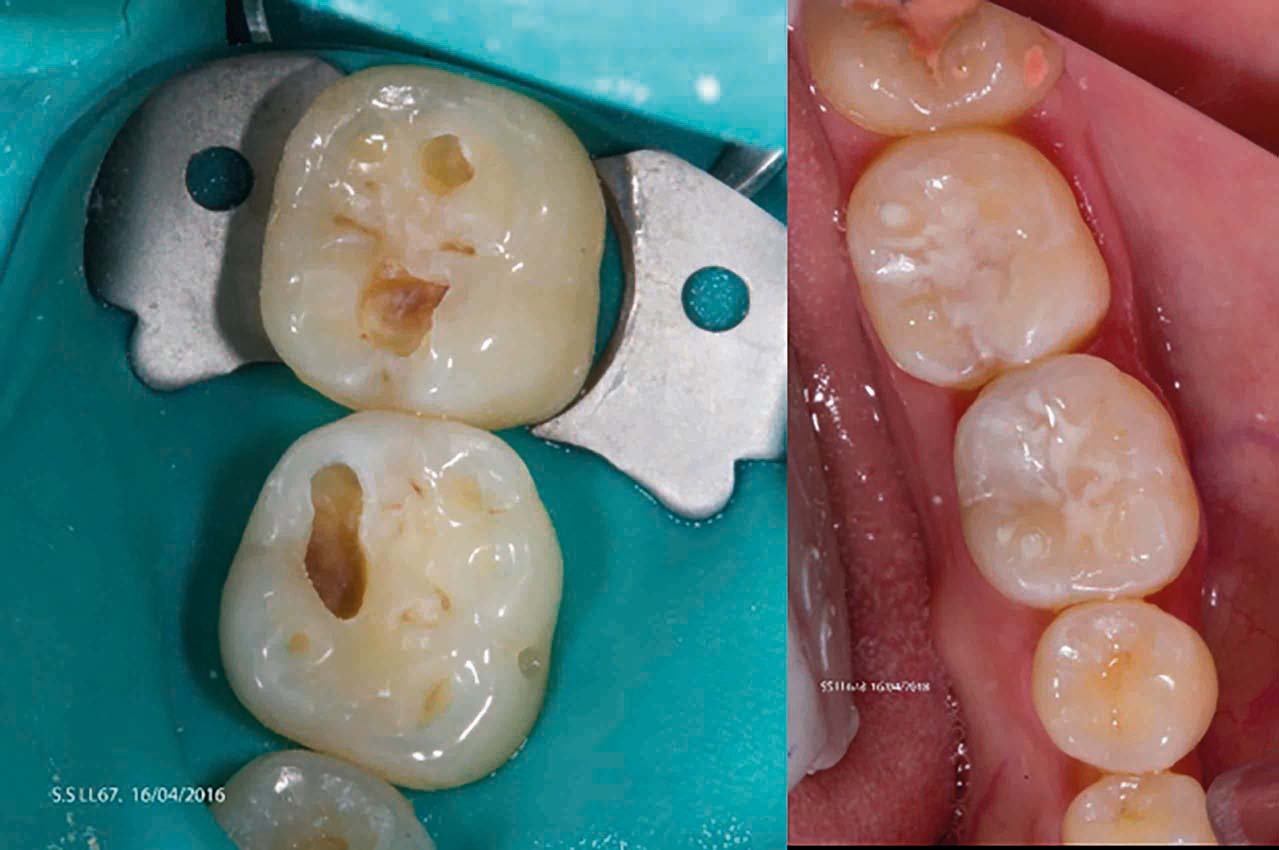
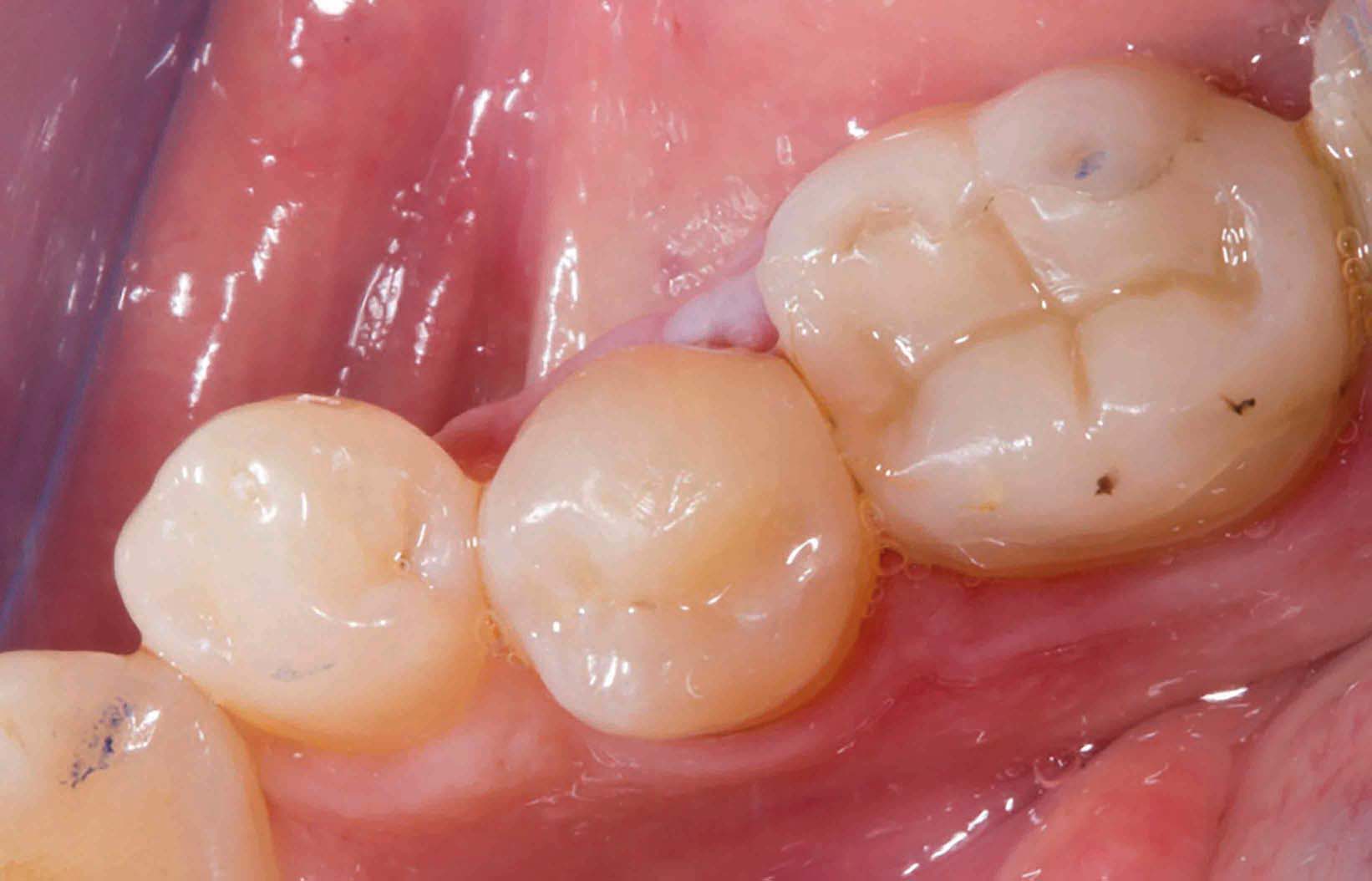
Manufacturer's comments
Dentsply Sirona would like to thank the members of the PREP Panel in evaluating and sharing the feedback around our recently introduced Class II Solution system. We are pleased with the responses received and believe that the findings of the study support our commitment to delivering better, safer, faster dentistry to clinicians. It is also worth pointing out, given the positive reception for ceram.X Universal that, on December 1st 2018, ceram.x Universal composite will be re-branded to Ceram.x Spectra™ ST composite − High Viscosity (HV). Each product in the Ceram.x Spectra™ ST Composite portfolio will continue to utilize Dentsply Sirona's novel SphereTEC filler technology to deliver optimized performance in the areas that matter most to dentists.

